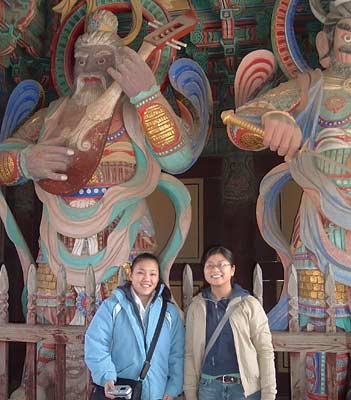Connecting Classroom and Country
Instead of heading to the beach or working for some extra cash over spring break, a group of 13 students and five professors embarked on a two-week trip to South Korea. The travelers were part of the Asian Studies course “Social Change in South Korea Through Film.” After six weeks of classes at Vassar, they headed to Asia to see firsthand the social, historical, and cultural dimensions of the country they had been studying.
Though study trips are offered by International Studies Department, this was the first time that such an opportunity was available through the Asian Studies Program. Thanks to grants from the Freeman and the Henry Luce Foundations, Asian Studies will offer study trips for at least three more years. This spring’s inaugural class was taught by Associate Professor of Sociology Seungsook Moon. “The trip was designed as a complementary element of the course,” said Moon. “It was meant to be an opportunity for students to get exposed to the social context that we have been studying through readings of written and visual texts.”
Using film as a major resource to examine social change was not an arbitrary choice. South Korean films have become increasingly popular in that country. According to Moon, this is in part due to the country’s economic, social, and political evolution. “Other Asian countries tend to look at Korea as a ‘successful’ case of economic development,” she said. Emerging artistic talent in the country has also heightened the quality of films and attracted a larger audience.
The class had weekly film screenings throughout the semester—which, along with required readings, helped prepare students and faculty members for their journey. “I chose serious and intelligent films that could convey the complex meanings of social change in Korean society,” said Moon. “Students told me that the use of visual texts combined with written texts enhanced their understanding of the multiple facets of societal transformation in contemporary South Korea.”

Bridget Leonard (left), daughter of Professor of Sociology Eileen Leonard, and Sara Bodach ’04
But the rich classroom experience was even more enhanced by the real thing. Upon arriving in Asia, the group wasted no time delving into Korean life. Their first activity was a tour of the demilitarized zone, which Moon called “a powerful legacy of the Korean War and a poignant reminder of the tragedy of the internecine civil war and national division.” This sight presented a stark contrast to the cosmopolitan capital of Seoul, a mere 25 miles away.
The group then embarked on a wide range of cultural outings. They saw the sights of Seoul (population approximately 14 million), visited an elementary school, participated in a Korean tea ceremony, and met with university students. After leaving Seoul, the group visited the city of Ulsan to observe the power of industrialization at a Hyundai factory.
Week two found the group at Seokguram Grotto and the Haeinsa temple, both World Heritage sites designated by UNESCO. They took a guided tour of Kyongju and explored Hahoe, a Confucian village in the North Kyongsang province. They also visited the city of Pusan, which has hosted the renowned Pusan International Film Festival. As a way of integrating their studies of Korean film into the trip, the students went to the film festival building for a “discussion about Korean film and modernization.” Moon pulled double duty for the event, acting as both moderator and translator.
When they returned from their journey, the class still had a few weeks left to meet. Privileged with a firsthand understanding of the country, the students were able to incorporate their observations and experiences into classroom discussion. “The trip enriched students’ understanding of the degree of social change in Korea,” said Moon.
“Visualizing Japan” is the title of next year’s study trip, to be led by Andrew Watsky, associate professor in art history. The class will visit historical and modern sites in Japan, including Nara, Kyoto, Hiroshima, and Tokyo. The purpose of the course is to “examine how Japanese artists and patrons have employed the visual over the long course of Japanese history,” and “how those places remain relevant in contemporary Japan.” Watsky is particularly excited to visit the pilgrimage site of Kumano-Nachi, as Vassar’s art museum recently acquired a 16th-century painting of the site.
“I think it’s going to be a great trip,” he said.
